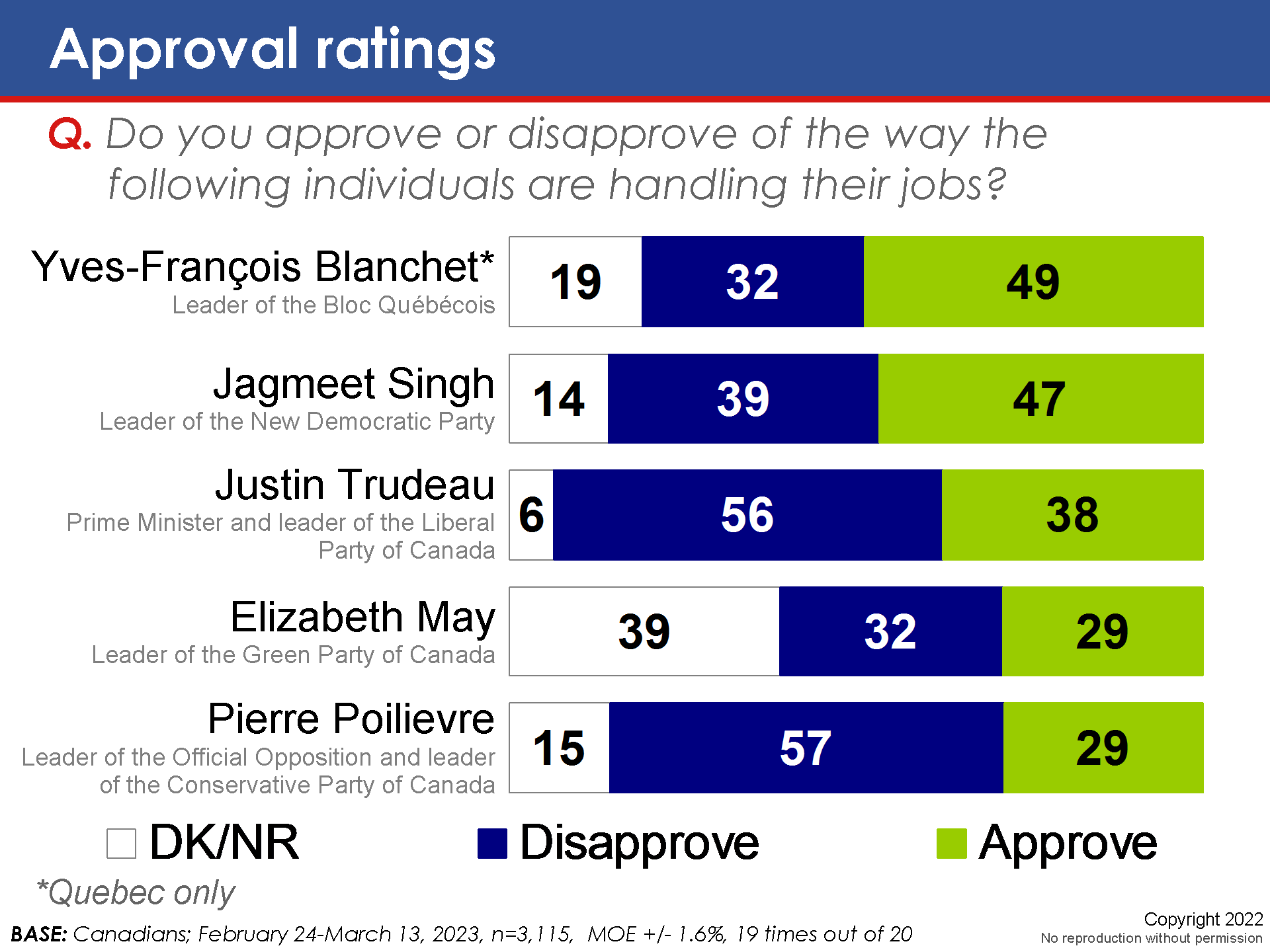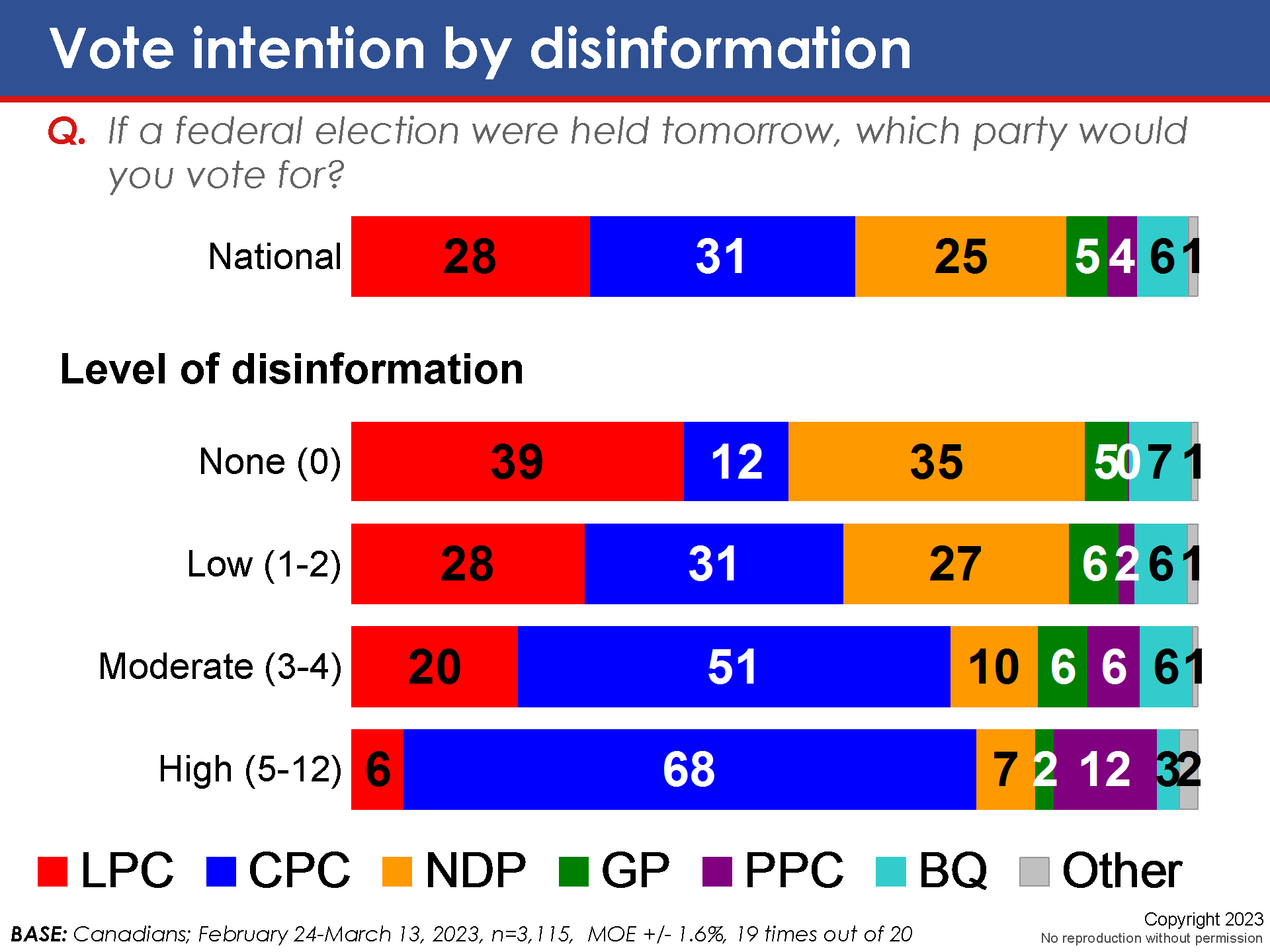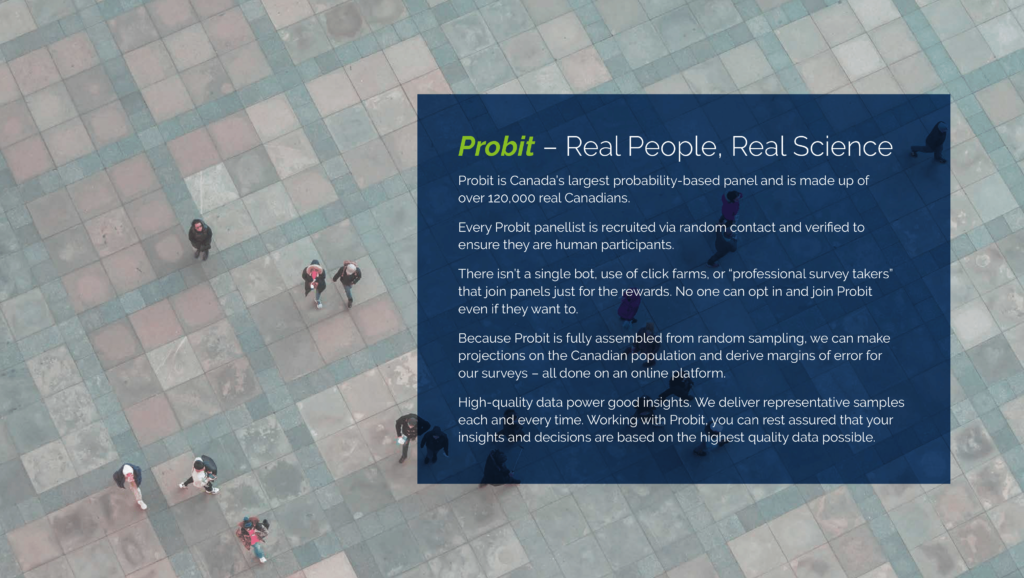NO CLEAR PATH TO POWER
[Ottawa – March 17, 2023] A deeply polarized electorate is divided three ways and no party has a clear path to power, a new EKOS poll has found. At 31 points, the Conservative Party has a three-point lead over the governing Liberals, who are at 28 per cent. Over the past few months, the Liberals have been losing ground to the third-place NDP who, at 25 points, are enjoying their highest standing since 2015, though these numbers would be well short of propelling Jagmeet Singh to victory if an election were held tomorrow.
The Conservative Party has a modest but significant lead, but the party is showing few signs of progress beyond its populist bedrock. Indeed, our data on second choice reveal few opportunities for growth from the centre, with some exposure to losses to the People’s Party on the far right. The Poilievre-led Conservatives find themselves in the conundrum of trying to court the centre-leaning voters without alienating the party’s “freedom” base. As usual, the party’s support is heavily concentrated in Alberta and Saskatchewan, which would lead to poor seat efficiency if an election were held tomorrow. Conservative support is also focused among men ages 35 to 64.
The Liberals have nothing to cheer about either. They are down five points from their 2021 election showing, owing mostly to poor support among youth. It is important to note that under-50 Canada looks very different across genders; whereas under-50 male Canada leans to small-c conservative options, under-50 female Canada leans NDP, both groups where the Liberals are being squeezed out. However, the Liberals do extremely well with the most reliable voting cohort – seniors – and the party still leads in seat-rich Ontario and Quebec, meaning these support levels may provide a deceptively low picture of what would actually happen in an election.
The erosion in Liberal support appears to have largely benefited the NDP. However, while this finding might look like good news for the NDP on the surface, the backbone of NDP support is largely made up of young people, particularly women under 35 where the party sits at an astonishing 53 points. The youth cohort – those under 35 – is a particularly fluid group and their loyalty could quickly swing back to the Liberals without notice. Furthermore, young people often have some of the lowest voter turnout rates in the country and the party’s surge with this group may not actually translate to votes. However, the NDP now lead with university graduates who, in contrast to young people, are a more reliable source of votes. The party also does quite well in Singh’s home territory of British Columbia, which also has a favourably-viewed NDP government.
At just four per cent nationally, support for the People’s Party is less than half what it was a year ago and its constituency is made up almost entirely of the strongest supporters of the so-called freedom movement that blockaded border crossings and shut down the capital in 2022. Indeed, the partisan links to the freedom movement are profound; support for the freedom movement is almost exclusive to supporters of the Conservative Party and People’s Party, while the movement is greeted with disdain everywhere else.
Another source of exposure for the Conservatives is Pierre Poilievre’s low approval score. Just 29 per cent of Canadians approve of how he is handling his job, while nearly twice that many – 57 per cent – disapprove. Justin Trudeau enjoys the approval of 38 per cent of Canadians (compared to 56 who disapprove), while Singh is the only one of the three main party leaders who enjoys a net-positive approval rating (47 per cent, compared to 39 per cent who disapprove). Yves-François Blanchet enjoys the approval of half of Quebecers (49 per cent), while Elizabeth May’s approval score has fallen to just 29 per cent; indeed, 39 per cent of respondents declined to opine on May, suggesting many Canadians do not even realize she is once again the party’s leader.
Approval scores for Trudeau and Singh are relatively stable. While we have no direct means of tracking Poilievre’s approval through time (given the recency of his ascendance to leader of the Conservative Party), we asked a similarly-worded question in September 2022 where respondents were asked to rate their impression of him as favourable, unfavourable, or neutral. Those expressing a negative view outnumbered those holding a positive view by 20 points; today, that gap has expanded to nearly 30 points.
Also notable is the dramatic correlation between Conservative support and disinformation, a link that is even stronger among People’s Party supporters. Among the fully informed (i.e., those who score 0 on our disinformation index), Conservative support sits at just 12 per cent. Among the least informed cohort, Conservative support soars to 68 per cent. Likewise, People’s Party support rises from literally 0 per cent to 12 per cent along the disinformation spectrum.
Finally, on a more positive note for the Conservatives, it is worth mentioning that the party holds a commanding lead among private sector union members, while the NDP does very well with the public sector. The Liberal Party, meanwhile, is getting squeezed out of the labour vote altogether.
All in all, this poll reveals significant movements among the electorate. There are now the starkest of divisions on institutional trust (the open-ordered axis), the informed versus disinformed, and those supporting the freedom movement. The ordered pole – or the populist pole – comprises about 36 per cent of Conservative and People’s Party voters. The rest of Canada are largely informed, moderately trusting, and hold the freedom movement in sharp disapproval. The ordered side is the most loyal, while the open side is more fluid. We have renewed evidence of oscillations among “promiscuous progressive” voters. However, none of these movements have done anything to produce clear path to a majority government for any party. Rather, the Canadian electorate continues to be gridlocked.
Description of disinformation index:
For this research, we tested five separate indicators of disinformation and we have constructed a disinformation index, a 15-point scale that measures how strongly respondents have bought into four pieces of disinformation and how strongly they reject one piece of correct information:
- Vaccine-related deaths are being concealed from the public;
- COVID-19 vaccines can cause infertility;
- COVID-19 vaccines can alter a patient’s DNA;
- Inflation is much higher in Canada than in the United States; and
- Climate change is caused by greenhouse gas emissions.
The index is constructed as follows:
- A respondent receives three points for every statement they rate as completely true (or completely false in the case of greenhouse gases causing climate change);
- A respondent receives two points for every statement they rate as mostly true (or mostly false in the case of greenhouse gases causing climate change); and
- A respondents receives one point for every statement they skip (in other words, every statement they are unable to correctly categorize as true or false); respondents do not receive a point for skipping the statement on inflation.
Methodology:
This survey was conducted using EKOS’ unique, hybrid online/telephone research panel, Probit. Our panel offers exhaustive coverage of the Canadian population (i.e., Internet, phone, cell phone), random recruitment (in other words, participants are recruited randomly, they do not opt themselves into our panel), and equal probability sampling. All respondents to our panel are recruited by telephone using random digit dialling and are confirmed by live interviewers. Unlike opt-in online panels, Probit supports margin of error estimates.
The field dates for this survey are February 24-March 13, 2023. In total, a random sample of 3,115 Canadians aged 18 and over responded to the survey. The margin of error associated with the total sample is +/- 1.6 percentage points, 19 times out of 20.
Please note that the margin of error increases when the results are sub-divided (i.e., error margins for sub-groups such as region, sex, age, education). All the data have been statistically weighted by age, gender, and region to ensure the sample’s composition reflects that of the actual population of Canada according to Census data.
EKOS follows the CRIC Public Opinion Research Standards and Disclosure Requirements.
Please click here for a copy of the data tables from this survey.
Please click here for a copy of the questionnaire that was used for this survey.

















Thank you Mr. Graves for your very informative demographic break down of voter intention. What is clear to me is the need to upgrade Canada’s electoral system by some form of proportional representation. The questions always seem to reflect a vote ‘for’ a party. Have you ever asked voters what party they would vote ‘against’ if they had the opportunity. A ballot first allowing one to register a vote against a candidate followed by votes for first, second, third choice candidates would reflect more completely the voters’ wishes. Too often the winning candidate is someone that the majority was not in favour of.
Interesting idea. How about a different poll “Who would you vote for in a proportional representation system?” It would be interesting to see what people’s votes would be like if they aren’t voting strategically based on their riding.
Interesting, but the link to the questionnaire is dead.